
Concrete is the most widely used building material made by man. Without it, modern life would not be the same. Concrete workers in New York City work on high rise buildings, hundreds of feet in the air, climbing on narrow wooden frames, and this work is often done on windy days, making their jobs even more difficult. These workers face serious safety hazards in the everyday performance of their jobs.
What Are the Most Common Hazards Faced By Concrete Workers?
NYC concrete workers perform their jobs with agility and skill on a daily basis, despite the risks. Common hazards faced by concrete workers include:
- Falls from heights with no guardrails at the top of buildings
- Loose materials, such as steel bars, wet cement, and wood falling from buildings
- Concrete slabs falling from cranes or forklifts and crushing workers
- Failure of the formwork in which concrete is poured, resulting in collapse
- Cement exposure causing chemical burns with direct contact or respiratory complications from breathing cement dust
- Rebar protruding from concrete slabs impaling or injuring workers
How Accidents and Injuries Be Prevented On Concrete Job Sites?
In addition to the risks of falling and structural collapses, concrete itself can cause injuries. This common building material is heavy and chemically hazardous. Concrete workers should take safety precautions to reduce the risk of injuries, including:
- Wearing respiratory protection: Concrete contains cement, sand, gravel, crushed stone, and water. Particles can become airborne when concrete is mixed and poured. Without proper protective equipment covering the nose and the mouth, tiny particles can enter the lungs. With repeated exposure, this can cause lung damage.
- Protecting the skin and the eyes: Concrete can severely irritate the eyes and cause chemical burns through direct or indirect contact. Cement, which makes up 10% to 15% of concrete, contains strong chemicals. Wet cement can seep through clothing, and workers can suffer chemical burns on the lower body from accidentally stepping or kneeling in wet concrete. Workers should wear protective goggles, clothing, and boots.
- Practicing proper back movements: Concrete slabs are heavy. Workers should bend the knees and keep the back straight in its natural alignment when lifting concrete and avoid twisting or bending while carrying heavy loads. Proper ergonomics are important to prevent overexertion injuries.
In addition to the above safety tips, concrete workers should follow the precautions generally recommended for construction workers. These include always having the appropriate safety gear, securing all equipment and temporary structures, participating in all available safety programs, and making sure you are properly trained before starting a new job or operating a new piece of machinery.
What Are the Risks Associated With Tools and Equipment Used in Concrete Work?
Like all construction workers, concrete workers face the risk of injuries associated with tools and equipment. Using a bull float with a handle 20 feet long or more can cause overhead electrical hazards. Power trowels can cause serious injuries when defective, or when they go out of control with operators who are not properly trained. Concrete workers can be seriously injured or killed in a fall from a forklift, when struck or crushed by a forklift, or when a forklift turns over.
Do You Need a New York Lawyer for Concrete Work Injuries?
If you have been seriously injured doing concrete work in New York, it is important to recover the maximum compensation available for your injuries. In addition to workers’ compensation, you may be eligible to file a third-party claim against a site owner, a contractor, or another party.
Call Wingate, Russotti, Shapiro, Moses & Halperin, LLP at (212) 986-7353 to schedule a free consultation. Our New York construction accident attorneys can explain your options under the law and work to recover the compensation you deserve.